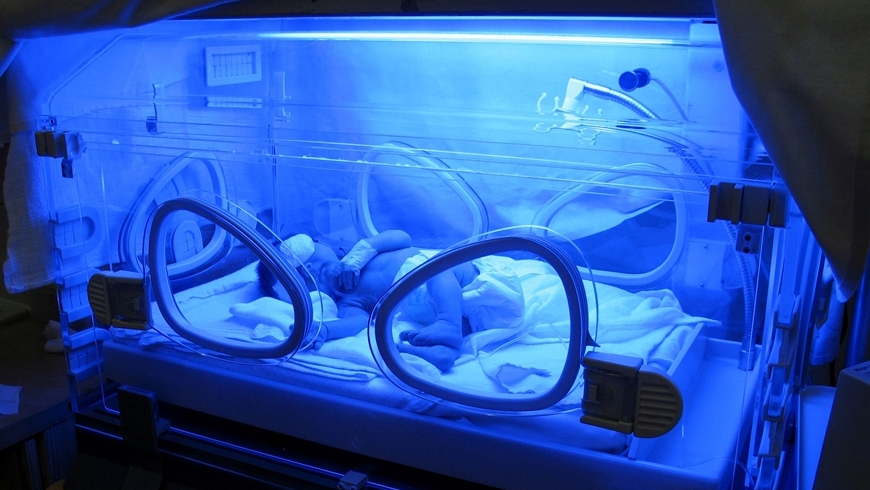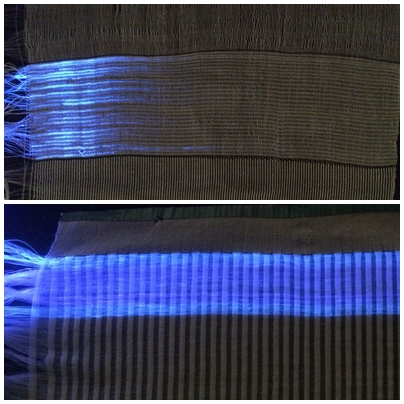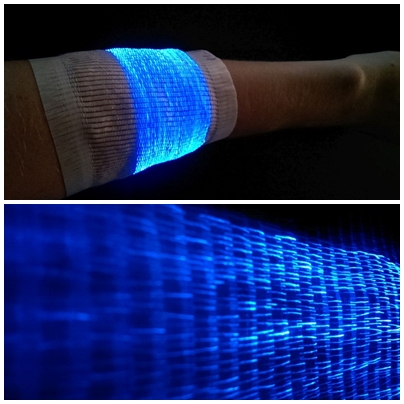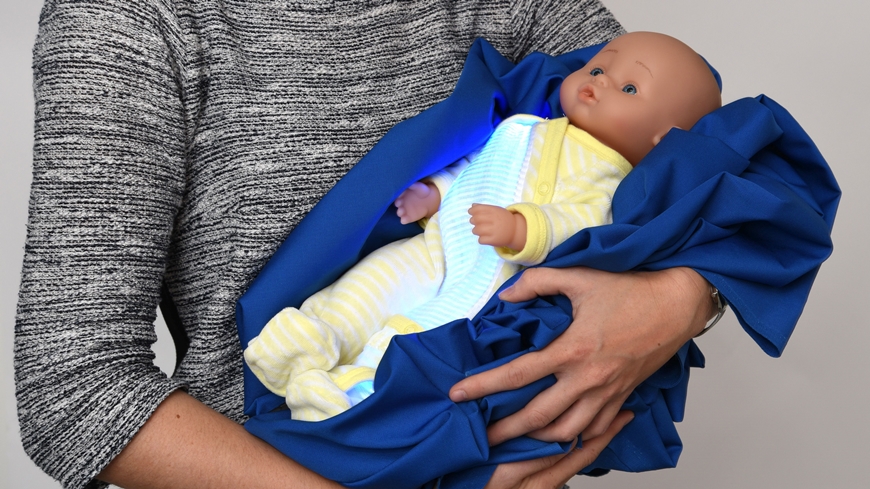Cozy treatment
Illuminated pajamas treat newborns
Babies who suffer from jaundice after birth are treated with shortwave light. Empa researchers have now developed illuminated pajamas that replace the treatment in an incubator. This means newborns can get healthy while warm and happy in their mothers' arms.

Alone, naked, and with their eyes covered for protection: this is how newborns lie in incubators when they are being treated for jaundice. Irradiation with blue light in an incubator is necessary because toxic decomposition products of the blood pigment hemoglobin are deposited in the skin in newborns with jaundice. Researchers of the Empa division Biomimetic Membranes and Textiles have now significantly improved the not-so-child-friendly procedure by combining the treatment with the needs of the newborns: The team, led by Luciano Boesel, developed illuminated pajamas for babies that turn the treatment into a wellness experience.
To do this, the material researchers created textiles with optically conductive fibers woven into them. Battery-operated LEDs serve as a light source for the light-conducting threads. Together with conventional thread, the optical fibers are woven into a satin material that distributes the light supply evenly throughout the fabric, as the researchers recently reported in the trade journal "Biomedical Optics Express".
Satin fabric is ideal

With a diameter of around 160 microns, the dimensions of the optical fibers match that of regular threads. Boesel's team determined the appropriate angle at which the threads must be bent during weaving so that the blue light stays in the therapeutic wavelength range of around 470 nanometers but is emitted onto the baby's skin, rather than staying in the fabric. The best result was achieved in a weaving process with a so-called 6/6 bond, which produces a satin cloth. Here, the optical threads have particularly few cross points with the traditional thread and are bent in an ideal way so the light is emitted uniformly over the skin.
The photonic textiles woven in this manner can be made into a romper or a sleeping bag so the little patient is clothed, and can be held and fed. And because the pajamas can be produced for commercial use so they only radiate light inward, onto the baby's skin, it is no longer necessary for the newborn to wear an annoying protective mask. Unlike in the incubator, where the treatment light shines on the infant's face, the shortwave radiation of the light pajamas doesn't reach the baby's sensitive eyes.
Light pajamas are gentle on the skin

Maike Quandt, lead author of the publication, says the illuminated fabrics are also suitable for everyday wear. "The photonic textiles are washable and tolerated well by the skin", the researcher says. In a thermoregulation model, the researchers studied how breathable the light textiles are. One of Empa's own skin models also proved that the pajamas also perform very well in terms of friction on the skin. "The satin fabric is smooth and matches the wearing comfort of a typical baby onesie," the material researcher says.
Infant jaundice is a common phenomenon, as babies' metabolisms are not very resilient within the first few days after birth. Normally, the liver disposes of many toxins in the body. With hemoglobin degradation, however, the child's liver may still be overwhelmed. If the toxic degradation product bilirubin accumulates in large amounts, visible yellow deposits occur in the skin. The situation then becomes dangerous if the bilirubin exceeds a certain threshold and the yellow pigment damages the brain. In severe cases of jaundice, the brain damage can only be prevented by a blood transfusion.
Blue light instead of blood transfusion

Today, light therapy in incubators prevents this dramatic development if it is applied in time. Light intensities of 30 microwatts per square centimeter in the blue spectrum transform the toxic bilirubin into a soluble form that can easily be removed by the infant's immature organs. The prototype of the pajamas currently radiates blue light from the photonic textiles at a lower light intensity. "For commercial production, the light intensity of the pajamas must therefore be increased somewhat," says Maike Quandt. However, this shouldn't be too big of a problem since it just requires the use of stronger LEDs.
BM Quandt, MS Pfister, JF Lübben, F Spano, RM Rossi, GL Bona, LF Boesel; POF-yarn weaves: controlling the light out-coupling of wearable phototherapy devices; Biomedical Optics Express, 2017; doi: 10.1364/BOE.8.004316
Leuchtpyjama gegen Gelbsucht
-
Share
